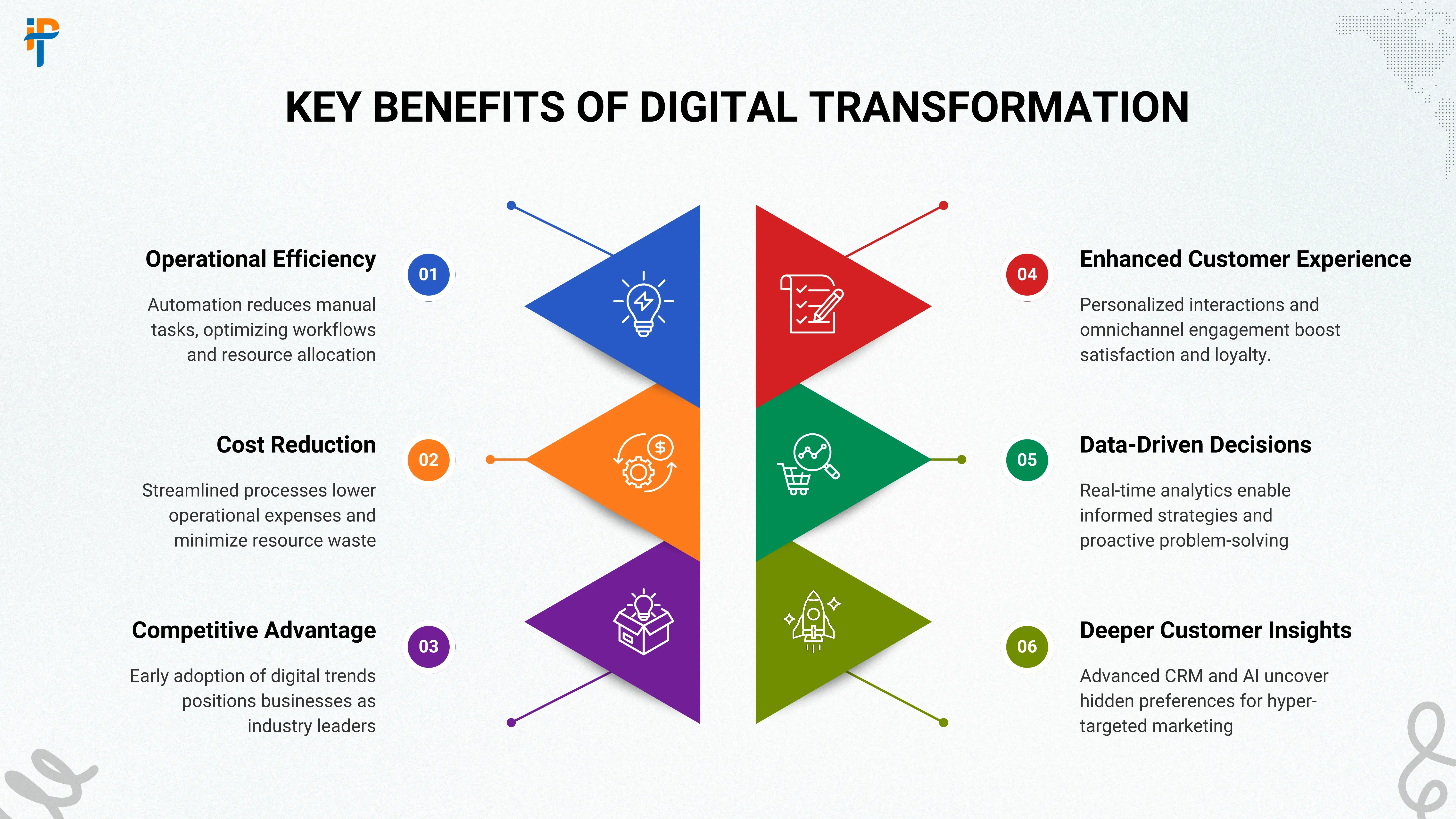What are the Key Benefits of Digital Transformation For Businesses?
Imagine a company where everything occurs at a faster pace—orders are filled up in a flash, customer questions are answered 24/7 by AI robots, and decisions are made using real-time data. It is not the future; it is already here, thanks to digital transformation.
Companies have been forced to move fast since the pandemic. Companies that adopted cloud computing, together with automation and AI, achieved superiority over businesses that used outdated systems with low digital speed. Digital transformation is not a choice anymore—it is a necessity for survival and growth.
But why are companies spending so much on digital transformation? What are the real Key Benefits of Digital Transformation they are getting? Let us break it down for you.
What is Digital Transformation?
Digital transformation is when a business applies the benefits of technology modernization to change how it works and serves customers. It's not just a case of buying new computers or software—it is changing how the business works to be faster, smarter, and customer-focused.
The following are the key elements of technology modernization advantages:
Process Automation – Utilizing technology to automatically undertake routine tasks (e.g., emailing, organizing files, tracking orders) so that other employees can devote more time to solving more critical tasks. Not only does automation reduce errors, save time, and make firms operate better, but it also incorporates efficiency.
Cloud Adoption – Instead of keeping files on one computer or server, businesses use the cloud (internet storage) so that they can access data anywhere. This allows teams to work together more easily, even if they're in other locations. It also allows businesses to grow without spending money on expensive hardware.
Data Analytics and AI – Businesses accumulate a lot of data (information) from customers, sales, and operations. Through data analytics, they are able to find trends, understand what customers want, and make more insightful decisions. Artificial Intelligence (AI) can even predict future trends, like which products will sell the most.
Customer Experience Modernization – Customers these days demand quick, easy, and customized service. Digital innovation in business helps organizations improve their websites, apps, and support systems so that customers get quick replies, frictionless shopping, and recommendations tailored specifically to them.
Also Read - Creating an MVP for Virtual Classrooms Key Features for Rapid User Adoption
Top Key Benefits of Digital Transformation
Digital transformation is the utilization of technology like computers, the internet, and smart machines to make business run more effectively. It allows businesses to accomplish things quickly, intelligently, and in a way that conserves time and money. Let us talk about the most significant key benefits of digital transformation in plain terms:

1. Improved Operational Efficiency
Digitalization eases work done on a day-to-day basis. Companies use computers and programs for unexciting and recurring tasks when their employees do not need to do anything else.
For example, instead of spending the entire day in form filling, it can be achieved by a computer application in mere seconds. More time remains in the hands of the employees to do those pivotal and inventive assignments that will support the growth of the company.
Also, smart systems like software and machines can do tasks without making as many mistakes as human beings tend to commit. This means the work is more precise and done in the same way every time. It helps companies operate more efficiently and quickly without spending time on error correction.
2. Better Customer Experience
One of the biggest hopes of any business is to have customers happy. Business process automation does a lot to assist with that. Most businesses now use omnichannel platforms, which enable customers to get in touch with the business using websites, apps, email, social media, or even live chat—all of it in one smooth and unified way.
You don't have to reexplain yourself if you switch from app messaging to emailing, for instance. Businesses also use AI chatbots, which are really smart robots you can converse with online.
Chatbots can reply to queries instantly and even suggest items based on your interests. This makes the customer feel special and attended to, which is really important for any business.
3. Smart Decision Making using Data
Businesses know a great deal of information—termed as data—concerning what individuals like, what they buy, and whether things are generally going well or not.
Technology helps to connect all this information in one place using centralized dashboards. It is like having super-smart control panels that show all of the important figures and facts together in one quick glance.
Also, companies are able to see what is happening in real time. What this means is that they will not have to wait until the month's end for a report. They can make quick and smart decisions based on what is happening right now. This helps them be able to fix problems immediately or capture new opportunities before they are gone.
4. Faster Time to Market
When a business has a new product or service concept, online tools help them get it out faster. It is called a shorter time to market. With methods like agile development, groups create the product in small steps and receive feedback quickly so they can keep working on it before it is done.
Cloud technology also helps. Firms can build apps or software on cloud-native environments and upload and update them quickly. They don't need to wait for extended installation time or spend days installing new systems.
5. Easier to Grow and Adjust (Scalability & Adaptability)
When a company grows, it needs more tools, space, or computer power. With digital transformation, companies can scale up or down depending on how many customers they have or how busy they are. If it's a busy time like a holiday sale, they can boost the power. If it's slow, they can reduce it to cut costs.
This is achieved using Cloud cost optimization, which simply implies using super-powerful web servers that can be adjusted at any time. It is leasing only what you need each time you need it. It also maintains the company's flexibility and readiness for whatever change is next.
6. Increased Innovation and New Ideas
Digital transformation enables firms to experiment with new concepts more readily. They have the ability to develop preliminary examples of new offerings, known as prototypes, using software that allows them to speedily create and test items. This allows them to determine what does and doesn't function before wasting their time or budget.
It also empowers businesses to utilize cutting-edge technologies like AI (Artificial Intelligence), IoT (Internet of Things), and blockchain. All these technologies facilitate businesses to conceive new innovative products and services that can potentially enrich lives.
7. Saving More Money
Going online isn't only making it easier for businesses to operate—it's also making them cheaper. One of the ways this is done is with pay-as-you-go. That is where businesses only have to pay for what they're using, such as renting a tool, rather than buying it outright.
Firms also do not have to spend loads of money buying expensive machines. Since the majority of software nowadays is cloud-based with cloud compliance certifications, they don't need too many computers and servers at the office. That means there's less cash that goes towards the machines, the electricity for running them, and maintenance.
8. Enhanced Security and Following Regulations
Securing data is very important. With digitalization, businesses use built-in security systems that comply with essential rules and regulations. These systems are typically followed by compliance certifications, which confirm that they are protecting customer data in the right manner.
They also have audit trails, which are like logs that show who did what and when. They employ access controls to allow only the right people to see or change sensitive information. This keeps hackers out and customer trust in place.
Also Read - 10 Signs Your Business Needs Legacy Software Modernization ASAP
Industry Use Cases
Digital transformation is using technology to make things work better. Let us see the impact of digital transformation and how it is revolutionizing healthcare, finance, retail, and manufacturing.
1. Healthcare
Telemedicine: Doctors can talk to patients through video conferencing. That means people don't necessarily have to go to the hospital in order to talk to a physician. It comes in handy, especially for those remote or cannot conveniently travel.
Electronic Health Records (EHR): No longer does a hospital have patient information recorded on paper, but instead computerized. More convenient and easier for doctors to find and adjust patient records.
Remote Patient Monitoring: Some patients have special gadgets that send health information back to doctors. Physicians then use this method to track patients' health without their presence.
2. Finance
Digital Onboarding: It is possible to open an online account at a bank. Individuals can complete forms and authenticate themselves on their phones or computers rather than taking time and multiple trips to the bank.
Fraud Detection using AI: Banks employ intelligent computer software to monitor for suspicious behavior, such as an attempt to steal money. The software can identify issues instantly and prevent fraud.
Mobile Banking Apps: People can see their account balances, transfer money, and pay bills using apps on their phones, which simplifies banking.
3. Retail
Personalized Shopping: Online shops track what people like and suggest things they might be interested in. This is more fun and personalized for all.
Inventory Automation: Stores automate what they have with technology. This enables them to know when they need to stock up on items and not be out of top sellers.
Omnichannel Experience: Customers shop in-store, online, or through apps, and their shopping experience is integrated across all platforms.
4. Manufacturing
IoT-Driven Operations: Factory floors utilize internet-connected devices and sensors to monitor machines and lines. They use this to deal with issues as soon as possible and to ensure things stay optimized.
Benefits of digitization for enterprises: Automation and robots are utilized by some enterprises to assemble products. Intelligent-systems might be faster, more accurate in some activities compared to humans.
Predictive Maintenance: With current technology, employees can be alerted in advance when a machine is going to fail, allowing them to take action and prevent production delays.
Also Read - Build vs Buy Software How to Make the Right Choice for Your Business
Challenges & ROI Considerations
1. Challenges in Digital Transformation
When companies try to utilize the key benefits of digital transformation in a bid to make their operations more efficient at work, certain problems arise. Let us look at such problems:
1. Inefficient Technology Systems
Most businesses still work with extremely outdated computer systems. These do not work well and are hard to network with the latest technology, making it more challenging to update and improve operations.
2. Resistance to Change
Sometimes, employees are used to doing things in a certain way and would not like to learn new procedures or equipment. This resistance might be an obstacle to the application of better technologies.
3. Lack of Trained Staff
New technology requires humans with the potential to run them. Without trained staff, it may be tough to implement such technologies effectively.
2. Solutions to Overcome These Challenges
To overcome these problems, companies can do the following:
1. Collaborate with Technology Experts
Collaboration with companies who possess experience working with new technology can help firms modernize their systems without interruption. These experts can provide tools and support that are needed.
2. Hire Consultants
Hiring professionals who understand key benefits of digital transformation can guide the company through the process so that everything gets done right.
3. Employee Training
Offering training sessions allows employees to acquire new technology usage, making them more comfortable with changes and improving overall productivity.
Measuring Success: Understanding ROI of Digital Transformation
ROI, or Return on Investment, is quantifying whether the time and money spent on new technologies are paying off. Here's how companies can quantify it:
1. Increased Revenue
Businesses can verify if their profits have risen after embracing new technologies, which implies that the changes are working in favor of the company.
2. Time Savings
If the work is being completed faster than before, then that indicates that the new technologies are getting more efficient with work.
3. Customer Satisfaction
Satisfied customers return and promote the business. The companies can determine if customers are happier by gathering feedback.
Future Trends in Digital Transformation
As the key benefits of digital transformation continue, organizations are looking for alternative ways to remain competitive and effective. Some trends shaping the future are as follows:
1. AI-First Enterprises
Some companies are putting artificial intelligence (AI) at the heart of their activities. In this, they utilize AI to drive decisions, personalize customer experience, and automate processes.
AI is utilized, for example, to predict what offerings might interest customers or optimize delivery routes to achieve maximum efficiency. Through the concentration on AI, companies aim to boost productivity and keep up with competitiveness in the industry.
2. Hyperautomation
Hyperautomation is a process of merging different technologies, such as AI, machine learning, and robotic process automation, to automate intricate business processes. Hyperautomation assists in making operations smoother, minimizing human errors, and improving efficiency in different departments. For example, automating customer inquiry handling or inventory management can help save time and resources.
3. Industry 4.0 & Edge Computing
Industry 4.0 is the fourth industrial revolution that embeds intelligent technologies like IoT, robots, and AI within production activities. Edge computing proves to be helpful by processing the data closer to where it is being generated, reducing latency, and allowing decision-making in real time. It enables more adaptive and efficient production systems through such fusion.
4. Sustainable and Ethical Tech Adoption
As the environmental problems mount, businesses seek to adopt technologies that are not only ethical but also sustainable. This means using energy-efficient data centers, reducing electronic waste, and ensuring that AI systems are transparent and equitable. By making sustainability and ethics their top priority, businesses are hoping to do good for society without sacrificing profitability.
Also Read - Top 12 Mobile App Monetization Strategies You Can’t Miss
Conclusion
Digital transformation is like bringing your business to the newest technology in order to work smarter and smarter. It helps businesses grow by making them more agile and improving the way they do things, sparking new ideas. If you are thinking about starting your own digital transformation, it is a good idea to start small and build up from there.
At IPH Technologies, we are ready to help with your digital transformation. We offer a free consultation to talk about how the key benefits of digital transformation and digital solutions can work for your business. You can also download our checklist, which gives you a step-by-step guide to digital transformation.
Frequently Asked Questions

Read more blogs

Time and Cost of Developing an AI like ChatGPT: Key Factors Explored
Explore the factors influencing the time and cost of developing an AI model like ChatGPT. Understand key considerations for successful AI ap

Guide to Successful Real Estate App Development: Features, Technologies, and More
Explore the advantages of developing a real estate app, key features, technologies to employ, and the importance of collaborating with a Rea

Custom vs. Template-Based Website Development: A Comprehensive Cost Comparison Guide
Explore the costs, pros, and cons of custom website development vs. template-based solutions. Make an informed decision for your online pres
